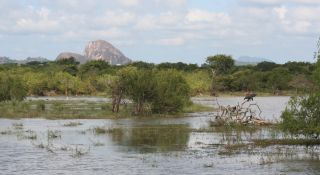CAN SNAKES CRAWL BACKWARD
( QUESTIONS AND ANSWERS ABOUT REPTILES)
Can snakes fly?
No. but some snakes , such as the flying snakes of southerst aia, can glige through the air as far as 80 feet (24m). to move from one tree to another, a flying snake hurls itself into the air from ahigh perch. At the same time, it raises its ribs and flattens its body, forming a king of parachute. Down it drifts-until it hits its landing spot.
can snakes swim?
Many can. like most land snakes, snakes that live in water form their bodies into s-shaped cures. the rear edge of each curve pucher against the water to send the snake forward.
do snaker have bones in therir bodies?
Yes-even though they not seem to. snakes hae a skull, ribs, and a very long spine,or backbone, made up of as many as 500 small bones called vertebrae(VUHR-tuh-bray).(you have only 33 vertebrae.)the vertebrae are like links in a chain that let the snake twist,turn, and coil.
Are snaer wet and slimy?
No. like all reptiles, snakes have dry skin. the skin is coered with a single layer of overlapping scales that are made of material similar to your figernails. the skin s main job is to keep in moisture and prevent the animal from drying out. this is very useful for animals that lie in the desert- as many snakes do.
Do snakes swerat?
No. no matter how hot they get, snakes don t perspire. their skins are watertight. in fact, snakes have no way of cooling off when the sun is very hot. all they can do is seek a shady spot or burrow into the ground.
Tuesday, December 28, 2010
Saturday, November 27, 2010
sri lanka animals
 Near sunset the flying foxes take flight for a night of fruit & nectar feeding |
Wednesday, November 24, 2010
sri lanka navy
23-Nov-10 09:25
 Naval troops attached to Naval Deployment Pulmudai in the Eastern Naval Area on information received from Navy Intelligence Personnel recovered 125 grams of Gelignite hidden in the beach area closer to the Pulmudai light house on 21st November 2010.
Naval troops attached to Naval Deployment Pulmudai in the Eastern Naval Area on information received from Navy Intelligence Personnel recovered 125 grams of Gelignite hidden in the beach area closer to the Pulmudai light house on 21st November 2010.
Monday, November 22, 2010
sri lanka army
|
|
sri lanka elephant
| Browse Sections |
Elephant Spotting in Sri Lanka (Formerly Ceylon)

Working elephant, Gampola 2008 - Christine Hand
Spotting an elephant is a must for anyone travelling to Sri Lanka. Elephants can be encountered in almost any part of the island outside of the capital.
The Yala Wild Life Sanctuary
The Yala sanctuary is situated in the south-east corner of the island, approximately 190 miles from Colombo and can only be reached by road. The catchment area is large and there are several viewing stations. The sanctuary boast around 130 different species of birds, elephants, monkeys, mongeese, hornbills, jungle fowl, leopards, crocodiles, sambhur, spotted deer, wild buffalo and many other forms of animal life. Excellent facilities exist for camping and night spotting of animals at their watering hole. The sanctuary is closed for a few weeks during September and October.Th
sri lanka animals

What a fantastic place Sri Lanka is for seeing many of the wild animals of the Indian Sub-continent! This island-country off the southeastern coast of India is home to Asian elephants, leopards, monkeys, mongoose, sloth bears, jackals, Sambar and chital deer, water buffalo and wild boars. Reptiles and amphibians include crocodiles and venomous snakes such as kraits, vipers and cobras, plus the more friendly geckos, frogs, and lizards. Birdlife is extraordinary (and we've given birds their own web pages). Unfortunately, of the more than 80 species of mammals in Sri Lanka, at least 22 are threatened with extinction. Habitat destruction by deforestation and water pollution is the main threat to these animals. The on-going civil war has led to more destruction especially in the north where rebels have poached animals for food.
 Elephant Rock & wetlands in Yala National Park |
Birding is excellent in the hills, and around the lagoons, marshes and waterways of the coast, and certainly in Yala National Park with its dry scrub, rivers, and wetlands.
Photos were all taken in Yala National Park by Amanda Hacking, unless otherwise noted. All text and photographs are copyrighted.
Subscribe to:
Posts (Atom)
